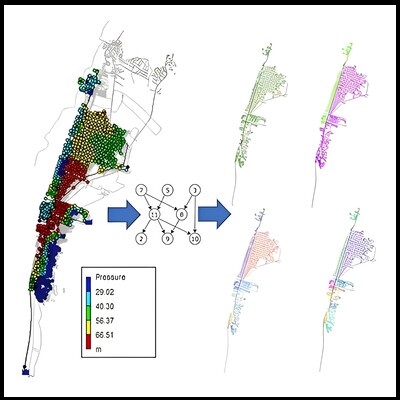Analysis of hydraulic sectorization in water distribution networks implementing Epanet and iDistritos
DOI:
https://doi.org/10.24054/bistua.v21i2.2432Keywords:
Water distribution systems, Graph Theory, Hydraulic Sectorization, Epanet, iDistrictsAbstract
The primary purpose of drinking water distribution networks is to supply drinking water to meet a population's quantity and quality needs. These systems are designed to continuously supply water to all inhabitants throughout the day. These optimal operating conditions in some cities are not achieved due to different problems that affect the regular operation of the distribution networks. This research presents a proposal to improve and optimize the hydraulic networks of the city of Los Patios, located in Norte de Santander, Colombia. This city currently presents problems in the operation of its distribution system due to population growth, informal settlements, lack of planning in constructing its pipe networks and water availability in the supply source. The current operation of the network is carried out by closing sectioning valves in order to generate sectors and thus guarantee service shifts that provide water by zones between two to three days a week, which does not comply with the service continuity criteria and affects the quality of the resource; in response to this problem, this research proposes several alternatives for hydraulic sectorization of the pipe networks using graph theory and the iDistricts and Epanet software. As a result, an optimization of the hydraulic operation of the distribution network was obtained, increasing the continuity of the service, and the actions and recommendations necessary to develop these alternatives are described.
Downloads
References
E. CAMPBELL GONZALEZ, “Propuesta para una metodología de sectorización de redes de abastecimiento de agua potable,” 2014, [Online]. Available: https://riunet.upv.es/handle/10251/39139
L. A. Rossman, H. Woo, M. Tryby, F. Shang, and R. Janke, Manual del usuario de EPANET 2.2. EPA, US Environmental Protection Agency, 2002.
J. C. Gil Jaramillo, Sistemas de distribución de agua con intermitencia de servicio. Gestión de demanda y optimización operacional. 2009.
L. F. Sandoval, J. R. R. y Zurvia-Flores, and G. T. López, “La sectorización en redes de agua potable para mejorar su eficiencia hidráulica,” Ing. Hidráulica y Ambient., vol. 37, no. 2, pp. 29-43 p., 2016, Accessed: Jun. 01, 2023. [Online]. Available: https://riha.cujae.edu.cu/index.php/riha/article/view/333
M. E. Castro-Gama, Q. Pan, A. Jonoski, and D. Solomatine, “A Graph Theoretical Sectorization Approach for Energy Reduction in Water Distribution Networks,” Procedia Eng., vol. 154, pp. 19–26, Jan. 2016, doi: 10.1016/J.PROENG.2016.07.414.
S. Takahashi and S. Adachi Takeshi Takemoto Minoru Umeki, “Featured Articles Water Distribution Solution for More Efficient Operation of Water Supply,” Hitachi Rev., vol. 64, no. 9, 2015.
S. Hajebi, S. Temate, S. Barrett, A. Clarke, and S. Clarke, “Water Distribution Network Sectorisation Using Structural Graph Partitioning and Multi-objective Optimization,” Procedia Eng., vol. 89, pp. 1144–1151, Jan. 2014, doi: 10.1016/J.PROENG.2014.11.238.
P. Gómez, F. Cubillo, and F. J. Martín, “Comprehensive and Efficient Sectorization of Distribution Networks,” Procedia Eng., vol. 70, pp. 753–762, Jan. 2014, doi: 10.1016/J.PROENG.2014.02.082.
M. M. Rokstad and K. Van Laarhoven, “Technical note: Graph-theory-based heuristics to aid in the implementation of optimized drinking water network sectorization,” Drink. Water Eng. Sci., vol. 15, no. 1, pp. 1–12, Jun. 2022, doi: 10.5194/DWES-15-1-2022.
R. A. Ospino, B. A. R. Valencia, and J. A. R. Valencia, “Sistema de adquisición de datos para el monitoreo de la calidad del agua a través de las variables de PH, conductividad, temperatura y oxígeno disuelto,” Rev. Colomb. Tecnol. Av., vol. 1, no. 17, 2011, Accessed: Jun. 01, 2023. [Online]. Available: https://ojs.unipamplona.edu.co/ojsviceinves/index.php/rcta/article/view/1979
O. T. Vegas Niño, F. Martínez Alzamora, and V. G. Tzatchkov, “A Decision Support Tool for Water Supply System Decentralization via Distribution Network Sectorization,” Process. 2021, Vol. 9, Page 642, vol. 9, no. 4, p. 642, Apr. 2021, doi: 10.3390/PR9040642.
A. D. Bonilla Granados, C. A., Tarazona Tobo, L. V. ., & Caicedo Calderón, “Análisis estadístico del consumo de agua potable residencial en Toledo, Colombia.,” BISTUA Rev. la Fac. Ciencias Básicas, vol. 20(1), pp. 70–75, 2022, doi: https://doi.org/10.24054/01204211.v1.n%25i.2022.1319.
O. Vegas, F. Martínez Alzamora, and V. Tzatchkov, “iDistritos: Sectorización de modelos de redes hidráulicas de Epanet,” Rev. Hidrolatinoamericana Jóvenes Investig. y Prof., vol. 5, pp. 13–15

Additional Files
Published
Versions
- 2023-12-12 (3)
- 2023-08-30 (2)
- 2023-08-30 (1)
Issue
Section
License
Copyright (c) 2023 © Autores; Licencia Universidad de Pamplona.

This work is licensed under a Creative Commons Attribution-NonCommercial-NoDerivatives 4.0 International License.
© Autores; Licencia Universidad de Pamplona





